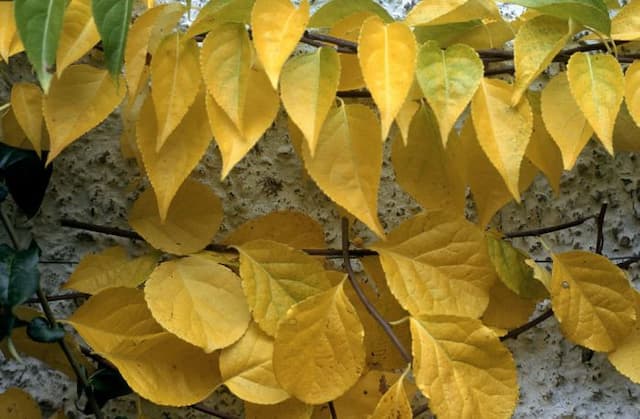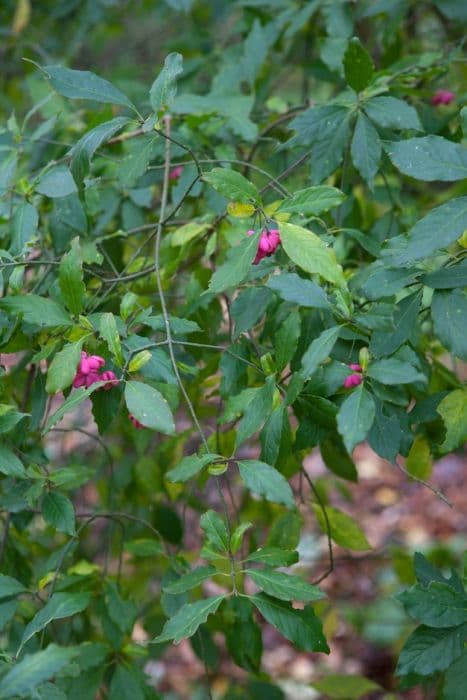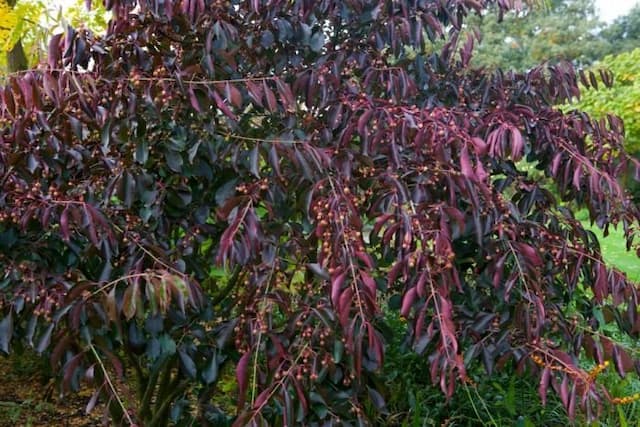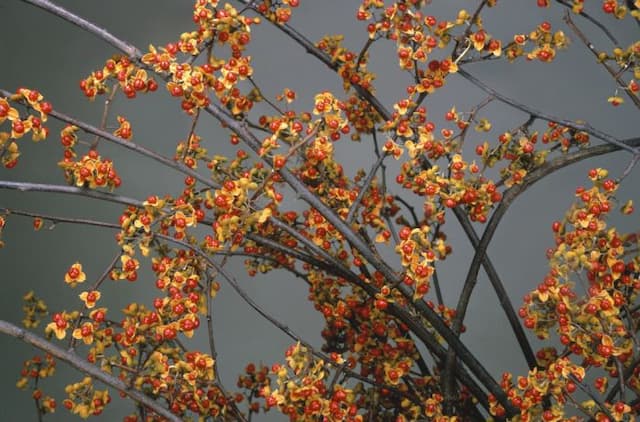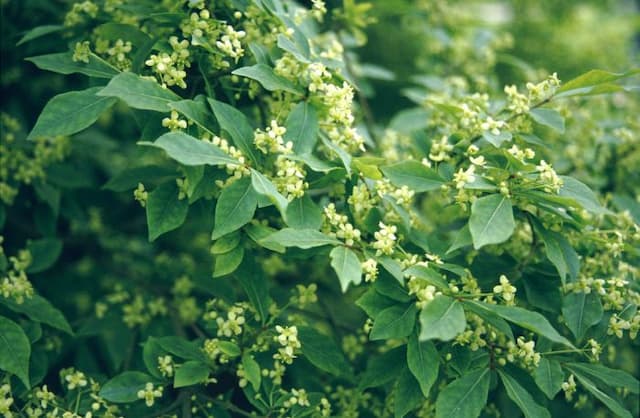Japanese Spindle Bush Euonymus japonicus 'Microphyllus Aureovariegatus' (v)

ABOUT
The Euonymus japonicus 'Microphyllus Aureovariegatus', commonly known as the variegated Japanese spindle, is a striking ornamental shrub known for its distinctive foliage. The plant showcases small, oval-shaped leaves that exhibit a beautiful variegation pattern. These leaves are characterized by their vibrant green color with irregular edges accented by contrasting creamy yellow or golden margins, creating a lively and colorful display. The balanced variegation gives the plant a speckled appearance from a distance, while a closer look will reveal the meticulous detail in each leaf's margin. When grown in optimal conditions, the variegated Japanese spindle maintains a lush, dense foliage that can add texture and visual interest to gardens year-round, as it is an evergreen shrub. The brightness of the variegated leaves can vary, and some may even have more pronounced golden tones, further enhancing the plant's decorative appeal. While blossoms are generally not the main appeal of this shrub, it can produce inconspicuous flowers that are often overshadowed by its striking foliage. The variegated Japanese spindle is versatile and can serve many roles in landscaping, from creating formal hedges to being a standout specimen in a mixed border. It’s the foliage with its unique variegation that truly defines the appearance and allure of this eye-catching shrub.
About this plant
 Names
NamesFamily
Celastraceae.
Synonyms
Japanese Spindle, Evergreen Spindle, Japanese Euonymus, Box-Leaf Euonymus, Variegated Japanese Spindle Bush.
Common names
Euonymus japonicus 'Microphyllus Variegatus', Euonymus japonicus 'Microphylla Variegata'.
 Toxicity
ToxicityTo humans
The Japanese spindle tree contains toxic compounds that can be harmful to humans if ingested. These compounds can affect the gastrointestinal system, causing symptoms such as nausea, vomiting, abdominal pain, and diarrhea. In severe cases, ingestion may also lead to more serious symptoms such as weakness, chills, convulsions, and rarely, life-threatening complications. It is important to avoid consuming any part of this plant.
To pets
The Japanese spindle tree is also toxic to pets, including dogs and cats. If pets ingest parts of the plant, they may experience symptoms similar to those in humans, such as vomiting, diarrhea, weakness, and abdominal pain. In severe cases, ingestion can result in more serious health issues, and the toxicity can be potentially fatal. Pet owners should ensure that their pets do not have access to this plant to prevent poisoning.
 Characteristics
CharacteristicsLife cycle
Perennials
Foliage type
Evergreen
Color of leaves
Variegated
Height
2-3 feet (0.6-0.9 meters)
Spread
2-3 feet (0.6-0.9 meters)
Plant type
Shrub
Hardiness zones
6-9
Native area
Japan China Korea
Benefits
 General Benefits
General Benefits- Ornamental Appeal: The 'Microphyllus Aureovariegatus' variety of Japanese Spindle has variegated leaves that add a decorative touch to gardens.
- Drought Tolerance: Once established, it has a good tolerance for dry conditions, requiring less water than many other shrubs.
- Low Maintenance: This plant requires minimal pruning and care once it has settled in its location.
- Compact Growth: It remains small and compact, making it suitable for gardens with limited space.
- Versatility: Can be used in a variety of landscaping designs, including formal gardens, hedges, or as a stand-alone specimen.
- Erosion Control: Its root system helps to stabilize soil and prevent erosion on slopes or banks.
- Year-Round Interest: With evergreen foliage, it provides color and structure throughout all seasons.
- Pest Resistance: Generally resistant to many common pests, reducing the need for chemical treatments.
- Adaptability: It can adapt to a range of soil types, although it prefers well-drained conditions.
- Wildlife Habitat: Provides shelter for small wildlife like birds and beneficial insects.
 Medical Properties
Medical PropertiesThis plant is not used for medical purposes.
 Air-purifying Qualities
Air-purifying QualitiesThis plant is not specifically known for air purifying qualities.
 Other Uses
Other Uses- Euonymus japonicus 'Microphyllus Aureovariegatus', also known as Golden Euonymus, can be dried and used in floral arrangements to add texture and a touch of variegation to the design.
- The dense foliage of Golden Euonymus makes it a natural choice for topiary art, allowing gardeners to shape and maintain intricate designs.
- Golden Euonymus can serve as a living fence or privacy screen when planted in a row, due to its ability to grow thick and maintain foliage from the ground up.
- The plant's sturdy branches can be used as natural supports for climbing plants that need assistance, like sweet peas or morning glories.
- Golden Euonymus can be planted in containers and used as a stable centerpiece in outdoor potted arrangements, especially in formal garden settings.
- Its colorful leaves can be used as a natural dye source for textiles, yielding subtle shades of green and yellow.
- The wood from mature Golden Euonymus shrubs can be harvested and used in woodworking for ornamental pieces, due to its fine grain.
- Incorporating Golden Euonymus into mazes or labyrinth gardens provides both structure and color contrast to these contemplative spaces.
- Artists can use the leaves of Golden Euonymus as stencils or stamps to create unique patterns in their artwork.
- Bonsai enthusiasts may use Golden Euonymus as a specimen for creating miniature trees due to its small leaves and the plant's adaptability to pruning.
Interesting Facts
 Feng Shui
Feng ShuiThe Japanese spindle is not used in Feng Shui practice.
 Zodiac Sign Compitability
Zodiac Sign CompitabilityThe Japanese spindle is not used in astrology practice.
 Plant Symbolism
Plant Symbolism- Resilience: Euonymus japonicus 'Microphyllus Aureovariegatus', commonly known as Japanese Spindle, is known for its hardiness and ability to thrive in various conditions, symbolizing the human ability to persevere.
- Versatility: This plant's adaptability to different environments and uses in landscaping reflects the quality of versatility and a flexible attitude in life.
- Longevity: The Japanese Spindle is a long-lived plant, representing enduring life, wisdom gathered over time, and long-term stability.
- Protection: In some cultures, planting a Japanese Spindle near the home is believed to offer protection against misfortune, symbolizing a safeguarding presence.
- Growth: The robust growth of this evergreen shrub can symbolize personal or spiritual growth, and the continuous evolution of one's character.
 Water
WaterThe Golden Euonymus should be watered deeply but infrequently, allowing the soil to dry out slightly between waterings. Generally, watering once a week is adequate, but this may vary depending on the climate and soil conditions. During the growing season, you might need to water more frequently, especially if planted in well-draining soil or during periods of drought. A good rule of thumb is to provide about 1 to 1.5 gallons per watering for an established plant, always checking the soil moisture before adding more water. In winter, reduce watering to prevent root rot as the plant's water requirements decrease.
 Light
LightThe Golden Euonymus thrives in full sun to partial shade but will exhibit the best color in full sun. It can tolerate some shade, but too much may lead to less vibrant foliage. Ideally, plant it in a location where it can receive at least 4 to 6 hours of direct sunlight daily to promote dense growth and vivid leaf variegation.
 Temperature
TemperatureThe Golden Euonymus can tolerate a range of temperatures and is hardy in USDA zones 6 through 9. It can survive minimum temperatures down to around -10°F and is comfortable up to 95°F, but the ideal growing temperature is between 60°F and 80°F. Ensure that it is not exposed to extreme cold or frost without protection, as this can damage the plant.
 Pruning
PruningThe Golden Euonymus should be pruned to maintain shape and encourage bushy growth. Prune in late winter or early spring before new growth begins. It can be pruned again in mid-summer if necessary to remove any dead or diseased branches. Pruning frequency depends on the desired shape and size, but generally, an annual trimming is sufficient.
 Cleaning
CleaningAs needed
 Soil
SoilJapanese Spindle 'Microphyllus Aureovariegatus' prefers well-draining soil with a mixture of 2 parts potting soil, 1 part perlite, and 1 part peat. The ideal soil pH should range between 6.5 and 7.5.
 Repotting
RepottingJapanese Spindle 'Microphyllus Aureovariegatus' should be repotted every 2 to 3 years or when roots become pot-bound to ensure continued growth and plant health.
 Humidity & Misting
Humidity & MistingJapanese Spindle 'Microphyllus Aureovariegatus' thrives in moderate humidity levels around 40-50%, but it is quite adaptable to different indoor environments.
 Suitable locations
Suitable locationsIndoor
Place in bright, indirect light and water when top soil is dry.
Outdoor
Plant in partial shade, protect from harsh sun.
Hardiness zone
6-9 USDA
 Life cycle
Life cycleThe Golden Euonymus (Euonymus japonicus 'Microphyllus Aureovariegatus') begins its life cycle with seed germination, usually in spring or early summer. The seedling stage follows, where the young plant develops a basic root system and a set of true leaves. During the vegetative stage, the plant experiences rapid foliar growth, establishing its variegated green and gold leaves that are characteristic of this cultivar. The maturation stage is marked by the Golden Euonymus reaching its full size and starting to produce its own seeds after flowering, though it is not known for its prominent flowers. Throughout its life, this evergreen shrub can undergo continuous growth and pruning to shape it as desired, fitting well into garden landscapes. The plant ultimately reaches the senescence stage where growth slows down, potentially living for many years before eventually dying.
 Propogation
PropogationPropogation time
Spring-Early Summer
The Euonymus japonicus 'Microphyllus Aureovariegatus', commonly known as Variegated Japanese Spindle, is often propagated through semi-hardwood cuttings. The best time for this is during the summer months when the plant's growth is most vigorous. To propagate, a cutting about 4-6 inches long is taken from a healthy parent plant, ideally including a small section of the stem's "heel" where it attaches to the main branch. The lower leaves are removed, and the cut end is dipped in rooting hormone to encourage root development. The cutting is then planted in a well-draining potting mix and kept moist but not waterlogged. It's essential to provide a warm environment and occasional misting to maintain humidity around the cutting. Roots typically develop within a few weeks, after which the plant can eventually be transplanted outdoors.
